Competition and Market Structures in Australia: A Detailed Analysis
VerifiedAdded on 2020/03/04
|6
|1435
|75
Report
AI Summary
This report provides a comprehensive analysis of market structures in Australia, focusing on oligopolies, duopolies, and monopolies. It examines the competitive landscape, highlighting key players such as Telstra, TPG, Optus, and Vocus within the broadband industry. The report delves into the role of the Australian Competition and Consumer Commission (ACCC) in regulating market behavior and promoting competition. It discusses the impact of the National Broadband Network (NBN) on market dynamics and the potential for increased competition. Furthermore, the report assesses the implications of market structures on consumers, suppliers, and new entrants. Recommendations are provided for government regulation to ensure fair pricing and encourage investment. The report concludes with an optimistic outlook for increased competition in the Australian broadband industry, emphasizing the benefits of ACCC actions for both consumers and suppliers.
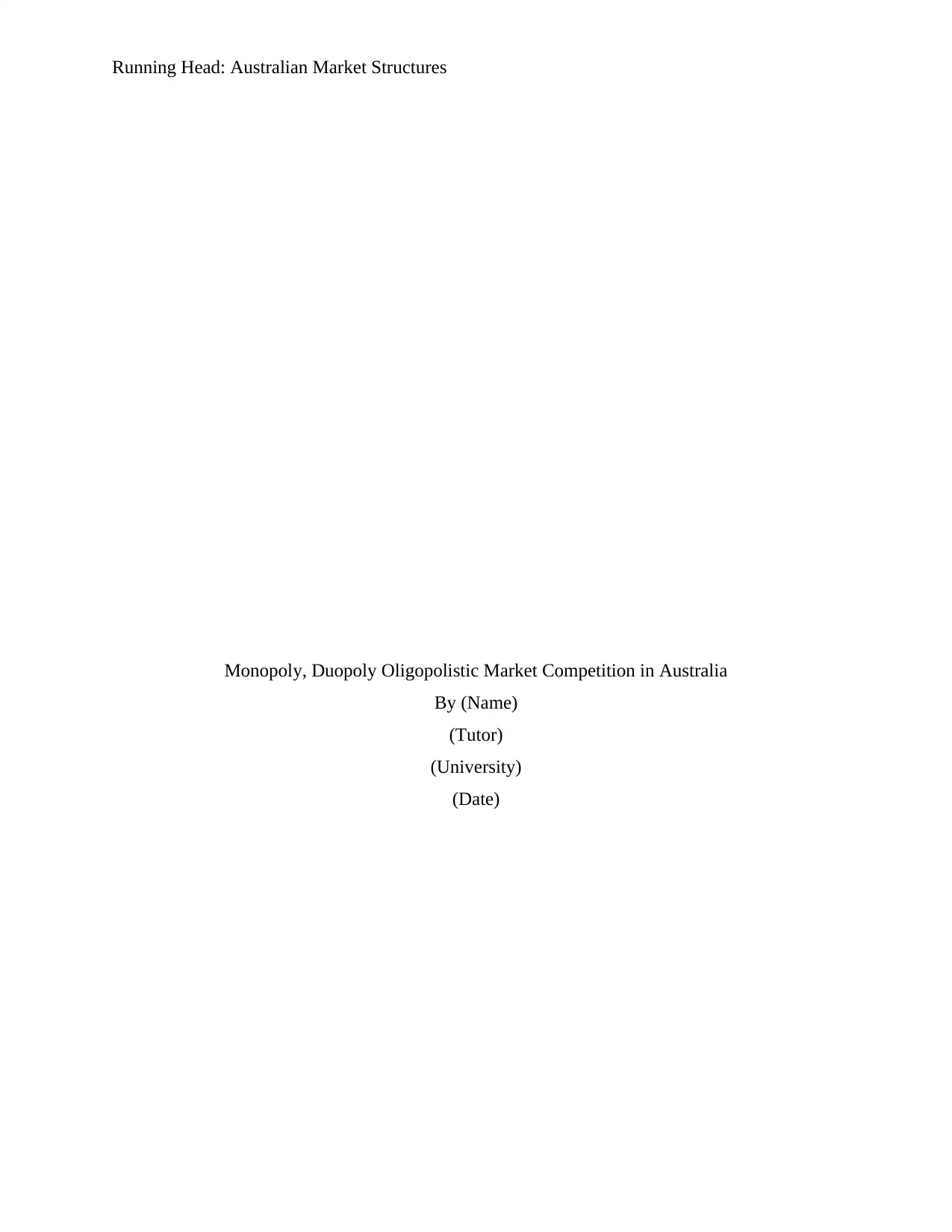
Running Head: Australian Market Structures
Monopoly, Duopoly Oligopolistic Market Competition in Australia
By (Name)
(Tutor)
(University)
(Date)
Monopoly, Duopoly Oligopolistic Market Competition in Australia
By (Name)
(Tutor)
(University)
(Date)
Paraphrase This Document
Need a fresh take? Get an instant paraphrase of this document with our AI Paraphraser
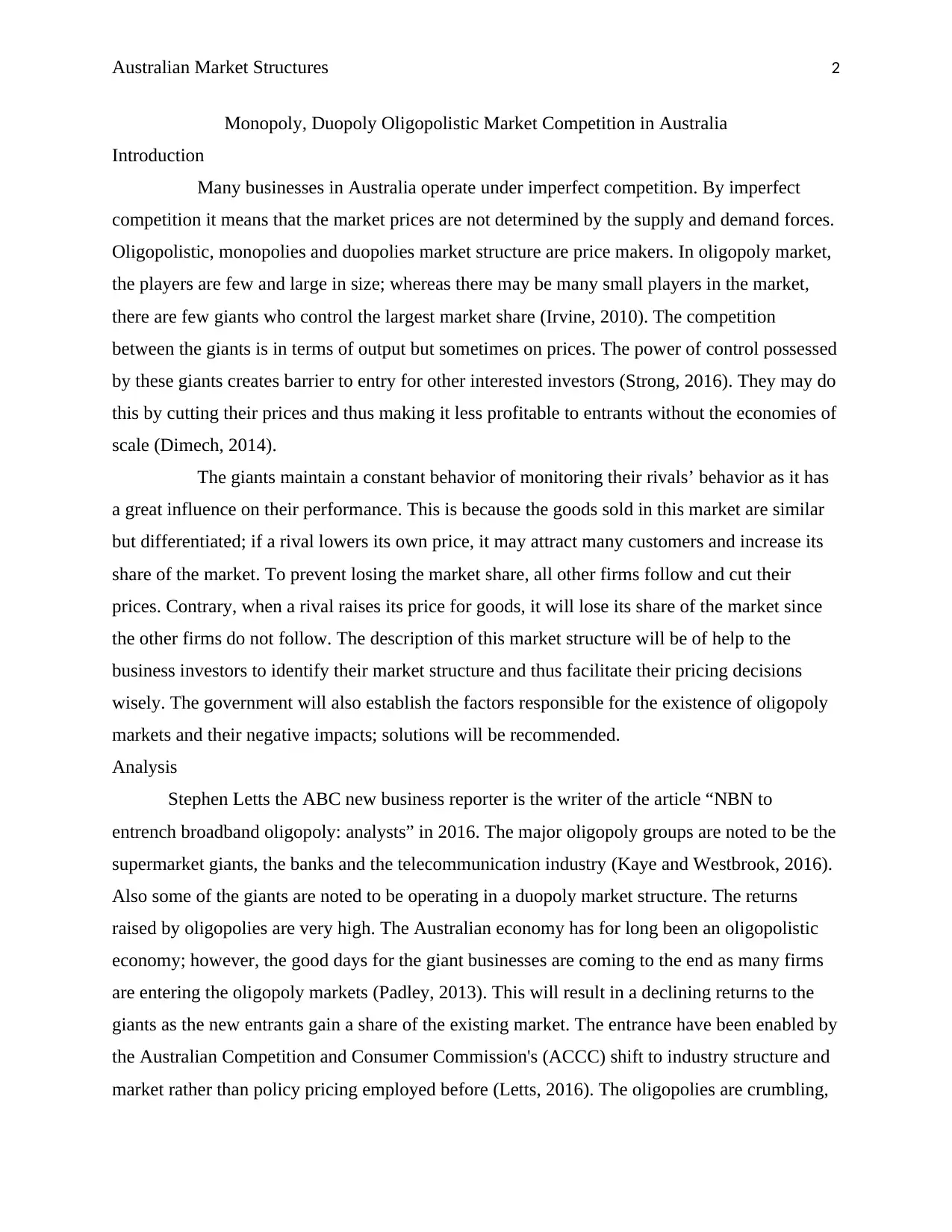
Australian Market Structures 2
Monopoly, Duopoly Oligopolistic Market Competition in Australia
Introduction
Many businesses in Australia operate under imperfect competition. By imperfect
competition it means that the market prices are not determined by the supply and demand forces.
Oligopolistic, monopolies and duopolies market structure are price makers. In oligopoly market,
the players are few and large in size; whereas there may be many small players in the market,
there are few giants who control the largest market share (Irvine, 2010). The competition
between the giants is in terms of output but sometimes on prices. The power of control possessed
by these giants creates barrier to entry for other interested investors (Strong, 2016). They may do
this by cutting their prices and thus making it less profitable to entrants without the economies of
scale (Dimech, 2014).
The giants maintain a constant behavior of monitoring their rivals’ behavior as it has
a great influence on their performance. This is because the goods sold in this market are similar
but differentiated; if a rival lowers its own price, it may attract many customers and increase its
share of the market. To prevent losing the market share, all other firms follow and cut their
prices. Contrary, when a rival raises its price for goods, it will lose its share of the market since
the other firms do not follow. The description of this market structure will be of help to the
business investors to identify their market structure and thus facilitate their pricing decisions
wisely. The government will also establish the factors responsible for the existence of oligopoly
markets and their negative impacts; solutions will be recommended.
Analysis
Stephen Letts the ABC new business reporter is the writer of the article “NBN to
entrench broadband oligopoly: analysts” in 2016. The major oligopoly groups are noted to be the
supermarket giants, the banks and the telecommunication industry (Kaye and Westbrook, 2016).
Also some of the giants are noted to be operating in a duopoly market structure. The returns
raised by oligopolies are very high. The Australian economy has for long been an oligopolistic
economy; however, the good days for the giant businesses are coming to the end as many firms
are entering the oligopoly markets (Padley, 2013). This will result in a declining returns to the
giants as the new entrants gain a share of the existing market. The entrance have been enabled by
the Australian Competition and Consumer Commission's (ACCC) shift to industry structure and
market rather than policy pricing employed before (Letts, 2016). The oligopolies are crumbling,
Monopoly, Duopoly Oligopolistic Market Competition in Australia
Introduction
Many businesses in Australia operate under imperfect competition. By imperfect
competition it means that the market prices are not determined by the supply and demand forces.
Oligopolistic, monopolies and duopolies market structure are price makers. In oligopoly market,
the players are few and large in size; whereas there may be many small players in the market,
there are few giants who control the largest market share (Irvine, 2010). The competition
between the giants is in terms of output but sometimes on prices. The power of control possessed
by these giants creates barrier to entry for other interested investors (Strong, 2016). They may do
this by cutting their prices and thus making it less profitable to entrants without the economies of
scale (Dimech, 2014).
The giants maintain a constant behavior of monitoring their rivals’ behavior as it has
a great influence on their performance. This is because the goods sold in this market are similar
but differentiated; if a rival lowers its own price, it may attract many customers and increase its
share of the market. To prevent losing the market share, all other firms follow and cut their
prices. Contrary, when a rival raises its price for goods, it will lose its share of the market since
the other firms do not follow. The description of this market structure will be of help to the
business investors to identify their market structure and thus facilitate their pricing decisions
wisely. The government will also establish the factors responsible for the existence of oligopoly
markets and their negative impacts; solutions will be recommended.
Analysis
Stephen Letts the ABC new business reporter is the writer of the article “NBN to
entrench broadband oligopoly: analysts” in 2016. The major oligopoly groups are noted to be the
supermarket giants, the banks and the telecommunication industry (Kaye and Westbrook, 2016).
Also some of the giants are noted to be operating in a duopoly market structure. The returns
raised by oligopolies are very high. The Australian economy has for long been an oligopolistic
economy; however, the good days for the giant businesses are coming to the end as many firms
are entering the oligopoly markets (Padley, 2013). This will result in a declining returns to the
giants as the new entrants gain a share of the existing market. The entrance have been enabled by
the Australian Competition and Consumer Commission's (ACCC) shift to industry structure and
market rather than policy pricing employed before (Letts, 2016). The oligopolies are crumbling,
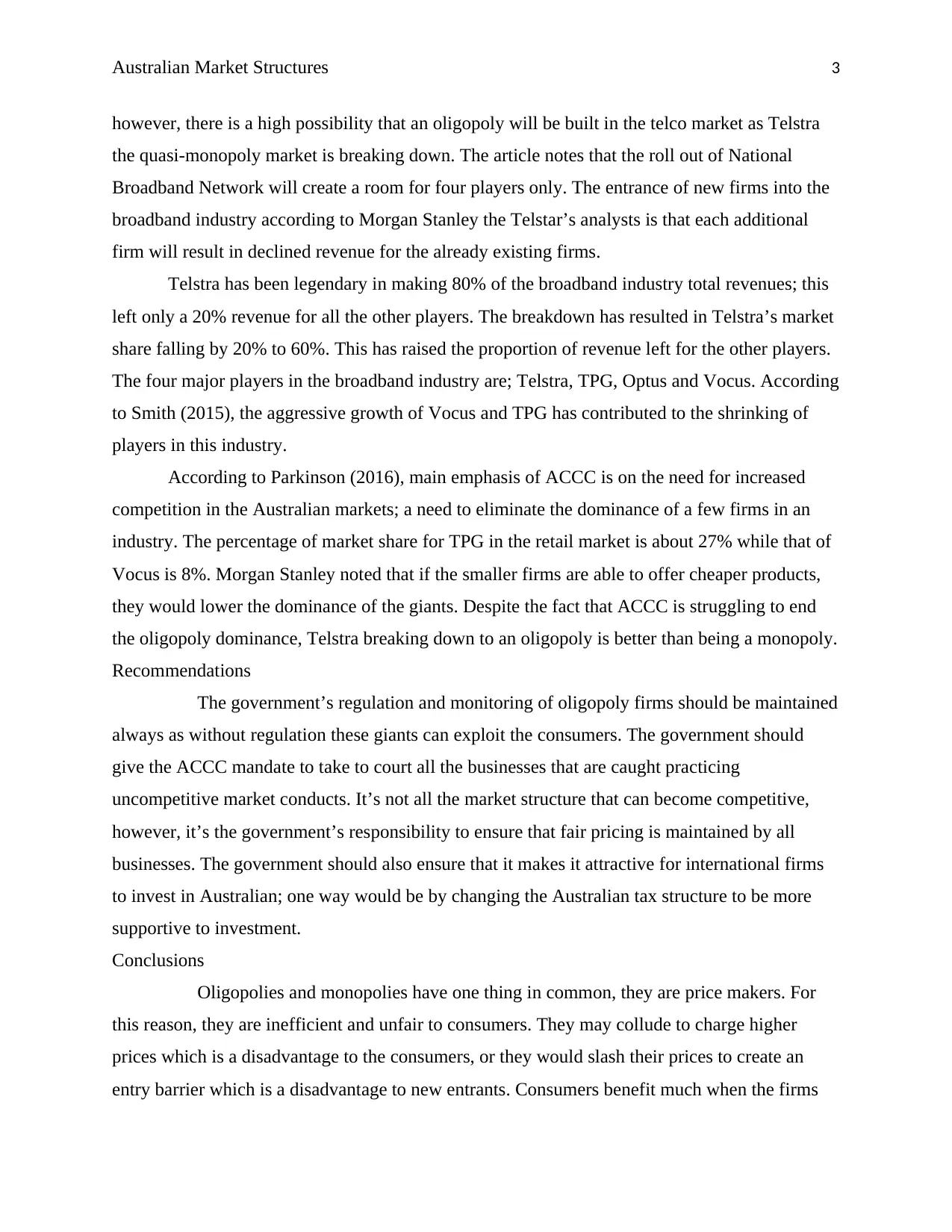
Australian Market Structures 3
however, there is a high possibility that an oligopoly will be built in the telco market as Telstra
the quasi-monopoly market is breaking down. The article notes that the roll out of National
Broadband Network will create a room for four players only. The entrance of new firms into the
broadband industry according to Morgan Stanley the Telstar’s analysts is that each additional
firm will result in declined revenue for the already existing firms.
Telstra has been legendary in making 80% of the broadband industry total revenues; this
left only a 20% revenue for all the other players. The breakdown has resulted in Telstra’s market
share falling by 20% to 60%. This has raised the proportion of revenue left for the other players.
The four major players in the broadband industry are; Telstra, TPG, Optus and Vocus. According
to Smith (2015), the aggressive growth of Vocus and TPG has contributed to the shrinking of
players in this industry.
According to Parkinson (2016), main emphasis of ACCC is on the need for increased
competition in the Australian markets; a need to eliminate the dominance of a few firms in an
industry. The percentage of market share for TPG in the retail market is about 27% while that of
Vocus is 8%. Morgan Stanley noted that if the smaller firms are able to offer cheaper products,
they would lower the dominance of the giants. Despite the fact that ACCC is struggling to end
the oligopoly dominance, Telstra breaking down to an oligopoly is better than being a monopoly.
Recommendations
The government’s regulation and monitoring of oligopoly firms should be maintained
always as without regulation these giants can exploit the consumers. The government should
give the ACCC mandate to take to court all the businesses that are caught practicing
uncompetitive market conducts. It’s not all the market structure that can become competitive,
however, it’s the government’s responsibility to ensure that fair pricing is maintained by all
businesses. The government should also ensure that it makes it attractive for international firms
to invest in Australian; one way would be by changing the Australian tax structure to be more
supportive to investment.
Conclusions
Oligopolies and monopolies have one thing in common, they are price makers. For
this reason, they are inefficient and unfair to consumers. They may collude to charge higher
prices which is a disadvantage to the consumers, or they would slash their prices to create an
entry barrier which is a disadvantage to new entrants. Consumers benefit much when the firms
however, there is a high possibility that an oligopoly will be built in the telco market as Telstra
the quasi-monopoly market is breaking down. The article notes that the roll out of National
Broadband Network will create a room for four players only. The entrance of new firms into the
broadband industry according to Morgan Stanley the Telstar’s analysts is that each additional
firm will result in declined revenue for the already existing firms.
Telstra has been legendary in making 80% of the broadband industry total revenues; this
left only a 20% revenue for all the other players. The breakdown has resulted in Telstra’s market
share falling by 20% to 60%. This has raised the proportion of revenue left for the other players.
The four major players in the broadband industry are; Telstra, TPG, Optus and Vocus. According
to Smith (2015), the aggressive growth of Vocus and TPG has contributed to the shrinking of
players in this industry.
According to Parkinson (2016), main emphasis of ACCC is on the need for increased
competition in the Australian markets; a need to eliminate the dominance of a few firms in an
industry. The percentage of market share for TPG in the retail market is about 27% while that of
Vocus is 8%. Morgan Stanley noted that if the smaller firms are able to offer cheaper products,
they would lower the dominance of the giants. Despite the fact that ACCC is struggling to end
the oligopoly dominance, Telstra breaking down to an oligopoly is better than being a monopoly.
Recommendations
The government’s regulation and monitoring of oligopoly firms should be maintained
always as without regulation these giants can exploit the consumers. The government should
give the ACCC mandate to take to court all the businesses that are caught practicing
uncompetitive market conducts. It’s not all the market structure that can become competitive,
however, it’s the government’s responsibility to ensure that fair pricing is maintained by all
businesses. The government should also ensure that it makes it attractive for international firms
to invest in Australian; one way would be by changing the Australian tax structure to be more
supportive to investment.
Conclusions
Oligopolies and monopolies have one thing in common, they are price makers. For
this reason, they are inefficient and unfair to consumers. They may collude to charge higher
prices which is a disadvantage to the consumers, or they would slash their prices to create an
entry barrier which is a disadvantage to new entrants. Consumers benefit much when the firms
⊘ This is a preview!⊘
Do you want full access?
Subscribe today to unlock all pages.

Trusted by 1+ million students worldwide
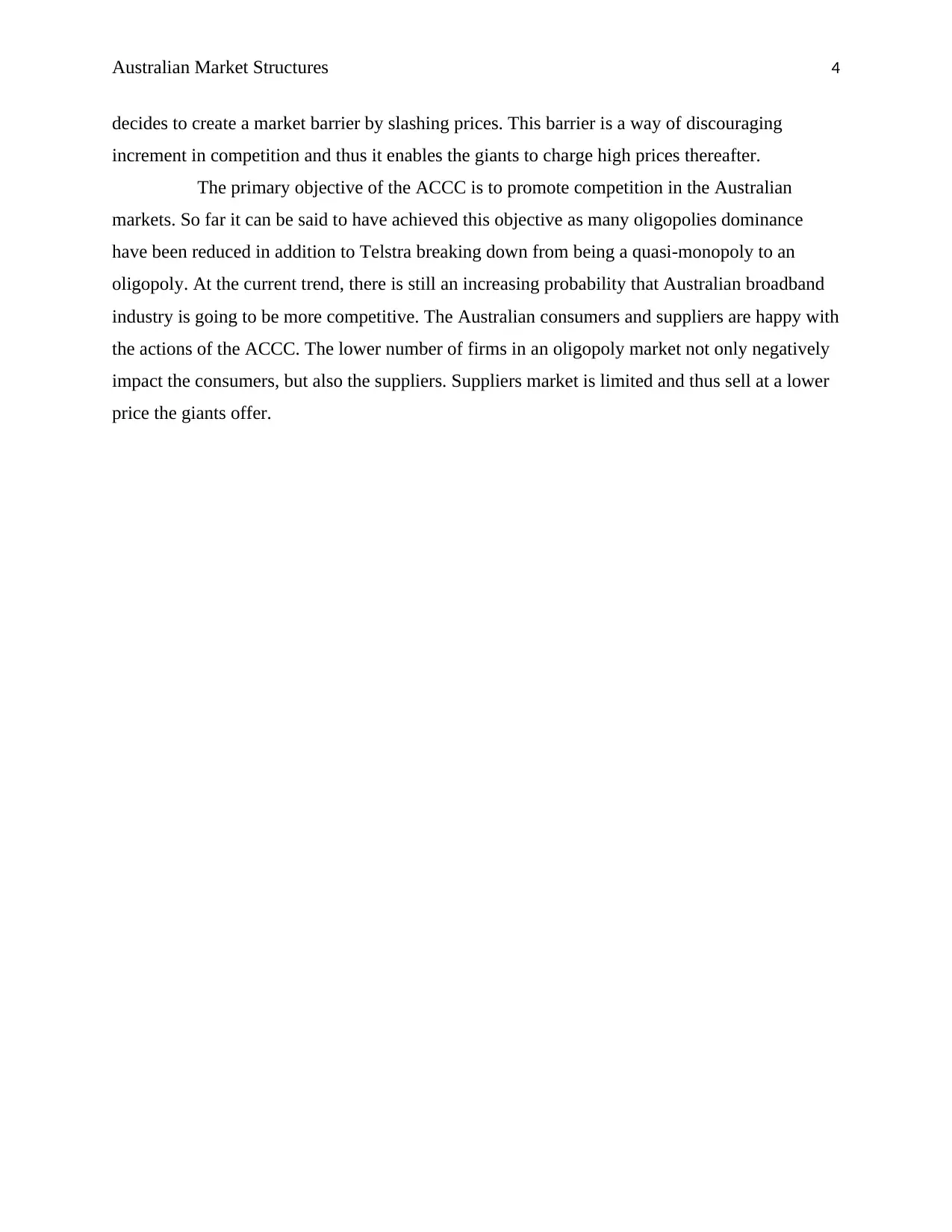
Australian Market Structures 4
decides to create a market barrier by slashing prices. This barrier is a way of discouraging
increment in competition and thus it enables the giants to charge high prices thereafter.
The primary objective of the ACCC is to promote competition in the Australian
markets. So far it can be said to have achieved this objective as many oligopolies dominance
have been reduced in addition to Telstra breaking down from being a quasi-monopoly to an
oligopoly. At the current trend, there is still an increasing probability that Australian broadband
industry is going to be more competitive. The Australian consumers and suppliers are happy with
the actions of the ACCC. The lower number of firms in an oligopoly market not only negatively
impact the consumers, but also the suppliers. Suppliers market is limited and thus sell at a lower
price the giants offer.
decides to create a market barrier by slashing prices. This barrier is a way of discouraging
increment in competition and thus it enables the giants to charge high prices thereafter.
The primary objective of the ACCC is to promote competition in the Australian
markets. So far it can be said to have achieved this objective as many oligopolies dominance
have been reduced in addition to Telstra breaking down from being a quasi-monopoly to an
oligopoly. At the current trend, there is still an increasing probability that Australian broadband
industry is going to be more competitive. The Australian consumers and suppliers are happy with
the actions of the ACCC. The lower number of firms in an oligopoly market not only negatively
impact the consumers, but also the suppliers. Suppliers market is limited and thus sell at a lower
price the giants offer.
Paraphrase This Document
Need a fresh take? Get an instant paraphrase of this document with our AI Paraphraser
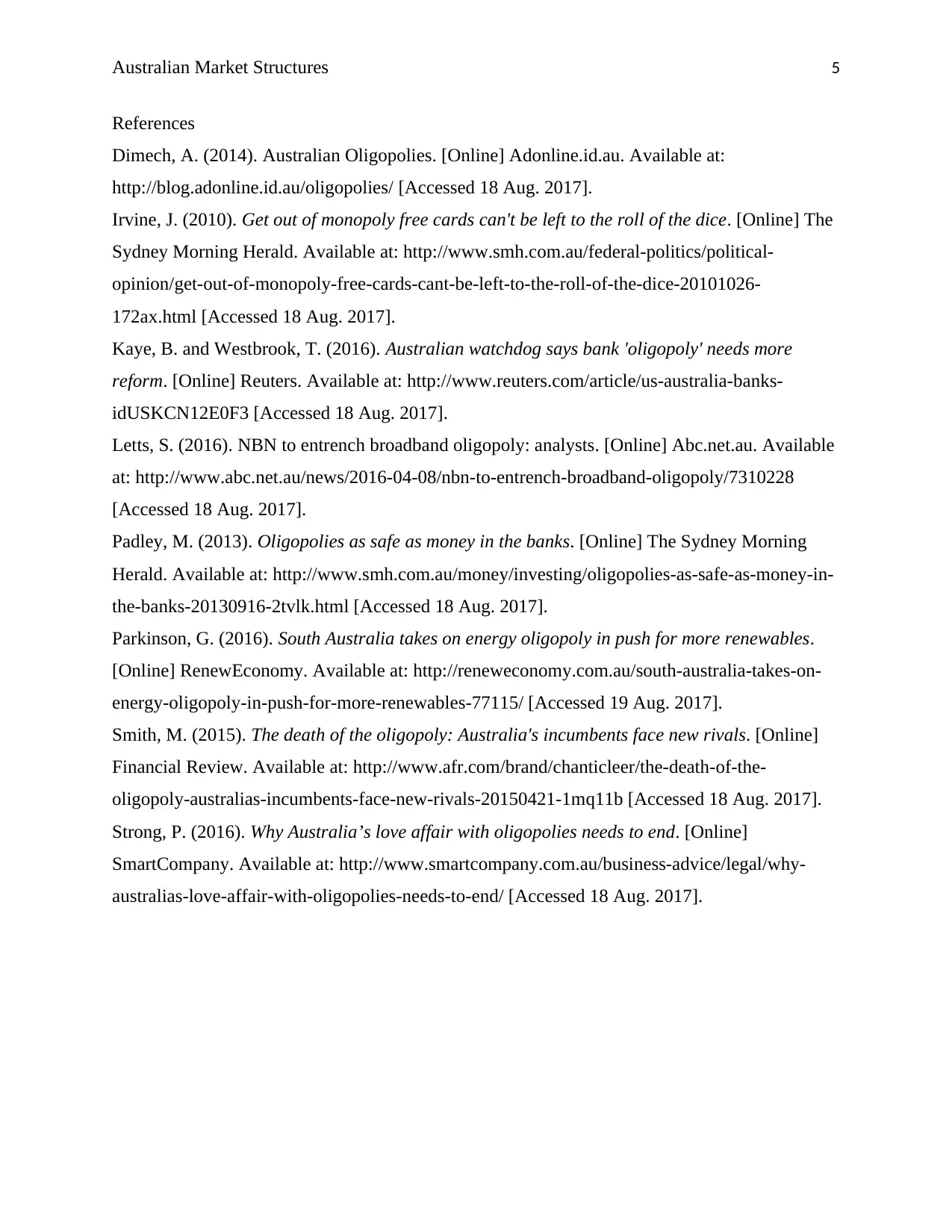
Australian Market Structures 5
References
Dimech, A. (2014). Australian Oligopolies. [Online] Adonline.id.au. Available at:
http://blog.adonline.id.au/oligopolies/ [Accessed 18 Aug. 2017].
Irvine, J. (2010). Get out of monopoly free cards can't be left to the roll of the dice. [Online] The
Sydney Morning Herald. Available at: http://www.smh.com.au/federal-politics/political-
opinion/get-out-of-monopoly-free-cards-cant-be-left-to-the-roll-of-the-dice-20101026-
172ax.html [Accessed 18 Aug. 2017].
Kaye, B. and Westbrook, T. (2016). Australian watchdog says bank 'oligopoly' needs more
reform. [Online] Reuters. Available at: http://www.reuters.com/article/us-australia-banks-
idUSKCN12E0F3 [Accessed 18 Aug. 2017].
Letts, S. (2016). NBN to entrench broadband oligopoly: analysts. [Online] Abc.net.au. Available
at: http://www.abc.net.au/news/2016-04-08/nbn-to-entrench-broadband-oligopoly/7310228
[Accessed 18 Aug. 2017].
Padley, M. (2013). Oligopolies as safe as money in the banks. [Online] The Sydney Morning
Herald. Available at: http://www.smh.com.au/money/investing/oligopolies-as-safe-as-money-in-
the-banks-20130916-2tvlk.html [Accessed 18 Aug. 2017].
Parkinson, G. (2016). South Australia takes on energy oligopoly in push for more renewables.
[Online] RenewEconomy. Available at: http://reneweconomy.com.au/south-australia-takes-on-
energy-oligopoly-in-push-for-more-renewables-77115/ [Accessed 19 Aug. 2017].
Smith, M. (2015). The death of the oligopoly: Australia's incumbents face new rivals. [Online]
Financial Review. Available at: http://www.afr.com/brand/chanticleer/the-death-of-the-
oligopoly-australias-incumbents-face-new-rivals-20150421-1mq11b [Accessed 18 Aug. 2017].
Strong, P. (2016). Why Australia’s love affair with oligopolies needs to end. [Online]
SmartCompany. Available at: http://www.smartcompany.com.au/business-advice/legal/why-
australias-love-affair-with-oligopolies-needs-to-end/ [Accessed 18 Aug. 2017].
References
Dimech, A. (2014). Australian Oligopolies. [Online] Adonline.id.au. Available at:
http://blog.adonline.id.au/oligopolies/ [Accessed 18 Aug. 2017].
Irvine, J. (2010). Get out of monopoly free cards can't be left to the roll of the dice. [Online] The
Sydney Morning Herald. Available at: http://www.smh.com.au/federal-politics/political-
opinion/get-out-of-monopoly-free-cards-cant-be-left-to-the-roll-of-the-dice-20101026-
172ax.html [Accessed 18 Aug. 2017].
Kaye, B. and Westbrook, T. (2016). Australian watchdog says bank 'oligopoly' needs more
reform. [Online] Reuters. Available at: http://www.reuters.com/article/us-australia-banks-
idUSKCN12E0F3 [Accessed 18 Aug. 2017].
Letts, S. (2016). NBN to entrench broadband oligopoly: analysts. [Online] Abc.net.au. Available
at: http://www.abc.net.au/news/2016-04-08/nbn-to-entrench-broadband-oligopoly/7310228
[Accessed 18 Aug. 2017].
Padley, M. (2013). Oligopolies as safe as money in the banks. [Online] The Sydney Morning
Herald. Available at: http://www.smh.com.au/money/investing/oligopolies-as-safe-as-money-in-
the-banks-20130916-2tvlk.html [Accessed 18 Aug. 2017].
Parkinson, G. (2016). South Australia takes on energy oligopoly in push for more renewables.
[Online] RenewEconomy. Available at: http://reneweconomy.com.au/south-australia-takes-on-
energy-oligopoly-in-push-for-more-renewables-77115/ [Accessed 19 Aug. 2017].
Smith, M. (2015). The death of the oligopoly: Australia's incumbents face new rivals. [Online]
Financial Review. Available at: http://www.afr.com/brand/chanticleer/the-death-of-the-
oligopoly-australias-incumbents-face-new-rivals-20150421-1mq11b [Accessed 18 Aug. 2017].
Strong, P. (2016). Why Australia’s love affair with oligopolies needs to end. [Online]
SmartCompany. Available at: http://www.smartcompany.com.au/business-advice/legal/why-
australias-love-affair-with-oligopolies-needs-to-end/ [Accessed 18 Aug. 2017].

Australian Market Structures 6
⊘ This is a preview!⊘
Do you want full access?
Subscribe today to unlock all pages.

Trusted by 1+ million students worldwide
1 out of 6
Related Documents
Your All-in-One AI-Powered Toolkit for Academic Success.
+13062052269
info@desklib.com
Available 24*7 on WhatsApp / Email
![[object Object]](/_next/static/media/star-bottom.7253800d.svg)
Unlock your academic potential
Copyright © 2020–2025 A2Z Services. All Rights Reserved. Developed and managed by ZUCOL.





